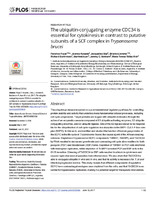Por favor, use este identificador para citar o enlazar este ítem:
http://sgc.anlis.gob.ar/handle/123456789/1439| Título : | The ubiquitin-conjugating enzyme CDC34 is essential for cytokinesis in contrast to putative subunits of a SCF complex in Trypanosoma brucei | Autor : | Rojas, Federico Koszela, Joanna Bua, Jacqueline Llorente, Briardo Burchmore, Richard Auer, Manfred Mottram, Jeremy C. Téllez-Iñón, María Teresa |
Palabras clave : | Trypanosoma brucei brucei | Fecha de publicación : | 13-jun-2017 | Editorial : | Yes | Journal: | PLoS neglected tropical diseases | Resumen : | The ubiquitin-proteasome system is a post-translational regulatory pathway for controlling protein stability and activity that underlies many fundamental cellular processes, including cell cycle progression. Target proteins are tagged with ubiquitin molecules through the action of an enzymatic cascade composed of E1 ubiquitin activating enzymes, E2 ubiquitin conjugating enzymes, and E3 ubiquitin ligases. One of the E3 ligases known to be responsible for the ubiquitination of cell cycle regulators in eukaryotes is the SKP1-CUL1-F-box complex (SCFC). In this work, we identified and studied the function of homologue proteins of the SCFC in the life cycle of Trypanosoma brucei, the causal agent of the African sleeping sickness. Depletion of trypanosomal SCFC components TbRBX1, TbSKP1, and TbCDC34 by RNAi resulted in decreased growth rate and contrasting cell cycle abnormalities for both procyclic (PCF) and bloodstream (BSF) forms. Depletion of TbRBX1 in PCF cells interfered with kinetoplast replication, whilst depletion of TbSKP1 arrested PCF and BSF cells in the G1/S transition. Silencing of TbCDC34 in BSF cells resulted in a block in cytokinesis and caused rapid clearance of parasites from infected mice. We also show that TbCDC34 is able to conjugate ubiquitin in vitro and in vivo, and that its activity is necessary for T. brucei infection progression in mice. This study reveals that different components of a putative SCFC have contrasting phenotypes once depleted from the cells, and that TbCDC34 is essential for trypanosome replication, making it a potential target for therapeutic intervention. |
Descripción : | Fil: Rojas, Federico. Instituto de Investigaciones en Ingeniería Genética y Biología Molecular (INGEBI-CONICET), Buenos Aires, Argentina. Fil: Koszela, Joanna. Institute of Quantitative Biology Biochemistry and Biotechnology, School of Biological Sciences, University of Edinburgh, King's Buildings, Edinburgh; Reino Unido. Fil: Bua, Jacqueline. ANLIS Dr.C.G.Malbrán. Instituto Nacional de Parasitología; Argentina. Fil: Llorente, Briardo. Instituto de Investigaciones en Ingeniería Genética y Biología Molecular (INGEBI-CONICET), Buenos Aires, Argentina. Fil: Burchmore, Richard. Institute of Infection, Immunity and Inflammation, College of Medical, Veterinary and Life Sciences, University of Glasgow, Glasgow, United Kingdom Fil: Auer, Manfred. . Institute of Quantitative Biology Biochemistry and Biotechnology, School of Biological Sciences, University of Edinburgh, King's Buildings, Edinburgh; Reino Unido. Fil: Mottram, Jeremy C. Centre for Immunology and Infection, Department of Biology, University of York, York; Reino Unido. Fil: Téllez-Iñón, María Teresa. Instituto de Investigaciones en Ingeniería Genética y Biología Molecular (INGEBI-CONICET), Buenos Aires, Argentina. |
URI : | http://sgc.anlis.gob.ar/handle/123456789/1439 | ISSN : | 1935-2735 | DOI: | 10.1371/journal.pntd.0005626 | Derechos: | Open Access |
| Aparece en las colecciones: | Publicaciones INP |
Ficheros en este ítem:
| Fichero | Descripción | Tamaño | Formato | |
|---|---|---|---|---|
| pntd.0005626.pdf | Artículo en inglés | 8.8 MB | Adobe PDF |  Visualizar/Abrir |
Visualizaciones de página(s)
101
comprobado en 27-nov-2025
Descarga(s)
16
comprobado en 27-nov-2025
Google ScholarTM
Consultar
Altmetric
Altmetric
Los ítems de DSpace están protegidos por copyright, con todos los derechos reservados, a menos que se indique lo contrario.

